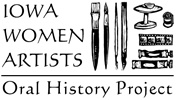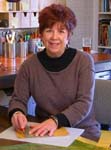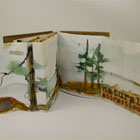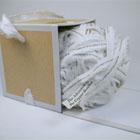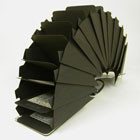PEGGY JOHNSTON
artwork | audio | statement | 2008 update | galleries
artwork
audio 
- Influential teacher (35 sec. | 276KB): listen | read
- Having kids (50 sec. | 393KB): listen | read
- Making books (73 sec. | 578KB): listen | read
- Buyer's response (44 sec. | 347KB): listen | read
- Making prints (75 sec. | 592KB): listen | read
- Not going to suffer (54 sec. | 426KB): listen | read
artist statement
My love of paper and fascination with containers made it almost inevitable that I would discover the book arts.
Since crafting my first books from handmade papers, I have explored book making as an art as well as a craft. I lean toward distinctive materials—old leather, metal, plastic other old books—in designing my one-of-a-kind works. The materials add a tactile aspect to the book. I love to search for just the right paper for a book. Other times, I'll run across a paper that suggests a book project or design to me.
Closures or clasps hold a particular interest for me, too. I enjoy developing an intriguing closure for a book, often employing novel materials and found objects. A fanciful or extraordinary clasp can bring a sense of privacy or an air of mystery to my work. It also adds a sense of anticipation and participation to the act of opening the book.
I focus on the book itself as an art object. The style of binding, the cover material, the pages, the shape, the closure—these are all elements of what I consider a functional piece of sculpture.
2008 update
My life hasn't changed much at all in the last ten years. I don't know if that is good or bad. I am better-known for my work, now, and have won some nice awards. I continue to teach wherever I can, whenever I can. I continue to accept commissions for books and related objects for special needs or occasions. I am one of the founding members of the Prairie Book Collaborative, a group dedicated to the book in all forms. We are in the process of finishing out third collaboration. It has run into many problems, but we are hoping that it will be finished in the next couple of months.
Yes, I am still making books. I think of myself as a sculptor with the book as my medium. My book works tend to be inspired by materials that come to me.
I hope that my skills have improved over the last ten years. I work hard at my craftsmanship. I take pride in the fact that most of my books are sturdily made and that they can withstand vigorous use. This is in regard to the blank books and journals that I sell. I also create exhibition pieces that are more sculptural in nature.
My motivation: Books incorporate virtually all of the arts and sciences as well as many crafts, so they are endlessly fascinating to me—here's my list which keeps growing.
BOOKS INCORPORATE MANY VISUAL ARTS & SCIENCES: Writing, Drawing, Painting, Printing, Calligraphy, Use natural dyes, Fiber arts, Paper making, Ceramics, Sculpture, Metal work, Jewelry techniques, Woodworking, Leather craft, Sewing, Math, History, Chemistry, Physics, Engineering.
audio text
Influential Teacher
My high school art teacher was an enormous influence on me. She would let us go. Because she had this plan—and it's very logical—we'd start with tempera, then we'd work up to casein, and then encaustic, and then oils, so that we're learning to work with thicker and thicker materials. And if I was ready to go with oils, she says, "Okay. Do it." And she would let us. She would never touch your work. She always asked, "Is it all right if I touch it?" before she would do anything, like show you how to do something. So she always was pushing us, and showing us other things and stimulating us.
Having kids
I graduated from college, became a mother, and turned 30, all in the course of a couple of weeks. And that was wild. But at that time, when I was pregnant with Graham, I was taking pottery and working on a kick-wheel. And I helped build a kiln. It never stopped me, I was right back. No, I never let them slow me down. I probably wasn't a very good mother, because I went ahead and did what I wanted anyway.
They each had a drawer with art supplies in the studio that they could use anytime. They did a lot of drawing and kid stuff. I even let them have the coloring books where you just put water and it's the magic paint. Totally non-creative, but it let me be creative, let me have my time. So they did a lot of that. But it hasn't carried over. Neither one of them have taken any art classes, except for this one book-binding. So, they're creative in different ways.
Making books
As far as the books that I make, I'm fascinated with the form and the structure, and I'm not interested in content much. But I look at my books more as a sculptural medium, and I'm interested in the shapes that I can get out of them, and exaggerating—maybe the cover's really thick with a really flat spine, that sort of thing. I am gradually getting some content. They're still functional—you could write in it—but it's more just an object. I guess I go more that way, as books as an object.
I love to combine the materials—the different papers and leathers and wood. I'm sort of like this little vulture. Always looking. I'm not above picking stuff up out of the street or the trash or whatever, if it looks like I could sew with it or if it would make a good cover. I love to go into stores like the Ax Man up in Minneapolis, it's just stuff, surplus stuff. And there's another one in Chicago called American Scientific Supply. That's where I got the little squares of mica that I've used for covers on books, and suture thread. I just look everywhere. I buy paper wherever I see it. Just kind of accumulate them and then dig through and get inspiration—I tend to gather the stuff and then get the ideas from the stuff.
Buyer's response
The books, I hope if they buy one that they use it, because I don't consider them finished until somebody puts something in it. I wish they wouldn't feel intimidated. I mean, it's just paper. People will say, "Oh, I'd be too afraid to write in it, I might make a mess." That just makes it better. I tell them, I don't care if you write grocery lists, actually that could be kind of neat. Ten years worth of grocery lists. So I want them to actually use them and finish them for me, because they're not done.
And my prints are small, and then what I do inside them is even smaller. I want people to look at them long enough to see all the little fun things that are happening in there. Because a lot of them actually have a little joke in the title, or the title might make a play on words that deals with whatever's in the print.
Making prints
I have no preconceived idea whatsoever with my prints. They just happen. I have these little bitty tiny plates. And I'd ink up my plate and I like to play with the brayer and make different patterns and watch what happens that way, and blend colors. And then I just take a pot scrubber or scraper and make some lines. Then comes the fun part, because I like to do the chine colle, which is collaging paper and printing all at the same time. Then you can take pieces of paper that you might want to show through some of the open areas in the ink—I like to use my little scraps of Japanese papers with tiny little patterns on them—and you paste up the backs and lay them face down. The paper goes on top, and when you print it, it glues the paper down to your substraight, and prints on top of the collaged paper. So you get all kinds of interesting things happening already. So I play with all that.
Then, I look at them and sometimes nothing happens, they don't say anything to me. Other times I'll look at them and I'll start making lines with, oh, crayon, colored pencil, pen and ink, markers, whatever, rubber stamps that I've carved, or shapes. I've sewn on beads, I've sewn on wire. I've glued more collage on top. Until suddenly it all comes together and I've got something happening.
Not going to suffer
I'm not one of those who expresses my emotions through my art. My art is more my escape, where I do other things and I don't think about that kind of stuff. I don't want to dwell on it. It's not productive, there's no reason.
I once read the artist's statement, and it says, “The artist does not choose to make a statement.” I'm just having fun, and I don't think there's anything wrong with that at all. I think, personally, a lot of artists take themselves way too seriously.
I don't think I have to suffer to create good art. I don't think all art has to have some deep meaning. It's perfectly all right for it to be decorative. That's a valid form of art. I mean, the main reason people buy art is because they think it's beautiful and they want to have it. I am serious about my art. Although I have fun with it, I'm still serious about it. I just figure, I'm not going to suffer. I have other ways to suffer; I don't need to suffer in my art.
